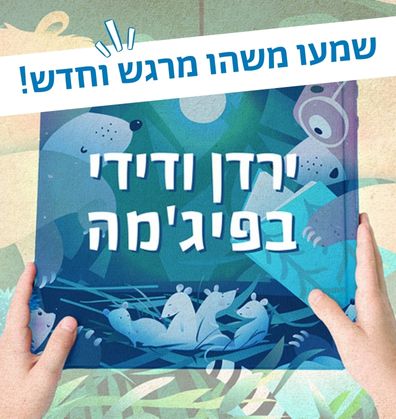סְּפָרִים
Book-Related Family Activities

Family reading advice
Books that describe familiar experiences in children’s lives are an opportunity for a glimpse into their world. While reading, you should pay attention to what the children notice most, the questions they ask, and the characters with which they identify. Sometimes, books make it easier to discuss things that happen in real life.

Discussion – Joining the game
Discuss with and ask the children: how do you think Birt felt when Shu joined their game? Have you ever played with a friend and had another person ask to join in? Have you ever asked to join other children?
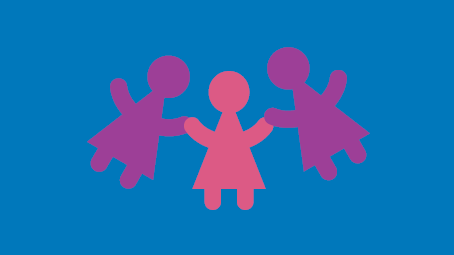
Arts & crafts with friends
Good friends can make a simple box into a palace, boat, or spaceship. You can suggest inviting one or several friends over for some joint arts & crafts time. Perhaps they will discover what else a box can turn into – with a little imagination, a pair of scissors, some markers, but most importantly – lots of togetherness.

Now Birt, then Shu, then Etho
Playacting is a great way of learning about the experience of others while expressing feelings and sensations. You can act this story out with the help of various family members or toys. Take turns playing each role, so that you can experience the story from the different characters’ perspectives.

Family reading advice
Children identify with the characters in the book, and acquire a better understanding of others who are different from them, thereby developing empathy and adaptability to new situations. While reading, you can focus on the characters’ facial expressions and ask: How do you think they feel? And why?

Discussion
You can discuss and ask: With whom and what do you like to play? In your opinion, what should we do when we each want to play a different game? What solutions can we suggest?
Annoying but also fun
Libby wants to join Pupik on his visit to the fire station, but he is annoyed – can a solution be found? Watch the video to find out!

Moving with the illustrations
Sitting, jumping, or perhaps bending down? Take turns choosing a page in the book, and showing the others a movement or posture similar to that of the characters depicted in the book. The other players can then imitate the movement, and look for it in the right page in the book. Did you find it? Then it is now time for the next player to choose a page.

The game of games
On separate notes, write down the games you like to play together: Hide-and-seek or maybe catch? Put all the notes in a box and choose one at random each day. What does it say? Would you like to play this game together? If not, you can always take another note out of the box or add a new note suggesting a new game.
A bit of advice when reading as a family
Toddlers like to be part of the story: Repeating words and sounds found in the book, or dramatizing the actions taken by the different characters. It is their way of identifying with the story, enriching their emotional worlds, and acquiring vocabulary and concepts. That is why, when reading together, you could “play” the trumpet, “beat” on a drum using your hands, and pretend you’re a choir conductor.
Playing music together
Almost any item can become a musical instrument: You could clap together to the rhythm of the song, or collect any instruments, rattles, and utensils you can find. A pot with spoons can be a drum, a used roll of paper towels can be a trumpet. You could even try to tap various materials to find out what kinds sounds tapping wood makes? And what about tapping the floor? Or metal? You may enjoy picking one of your favorite songs and playing it together.
A discussion on being together and apart
Gali and Gaya love doing stuff together, but also separately. You may want to discuss and discover what your toddlers like to do together with a sibling, friend or you, their parents, and what they prefer doing on their own.
Gali and Gaya come visit
Would you like to play with Gali and Gaya, and dramatize the story? Please scan the QR code, print out two adorable ducks, cut them out, and act the story out with them…!
Follow me! A motion game
Like Gali and Gaya, you too could walk together. How about making a trail at home, and marking it with a piece of rope or various items. Next, walk along it in single file, one behind the other, or perhaps together, side by side. You can also take turns being in the lead and exclaiming: “Follow me!”
Animals & illustrations
A sheep, frog or butterfly? You may enjoy looking at the illustrations in this book together, and discovering the various animals. You could make the sound that each oft them makes, or move like them: Flying like a butterfly, buzzing like a bee, or… What else?
Reading poems
The poems in this book present small moments in life. Every time you read together, we recommend selecting one poem, and reading it together. Does the poem remind you of something that once happened? This may be a good opportunity for you, parents, to share a childhood experience with your child, creating closeness and intimacy with them.
Pleased to meet you – Hagit Benziman
When did Hagit Benziman start writing? What does she write about, and why? You may want to scan this QR code to find out more about this author and her work.
Looking through the family album
You may enjoy looking at parents’ family photo albums together, searching for special childhood moments. You could also look at early childhood photographs of the children, and share information about the moments captured. Which memories do they evoke in you?
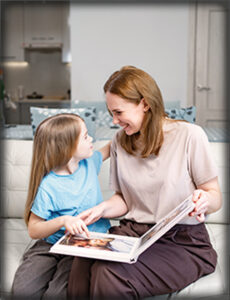
Dramatizing together
Do you have a favorite poem among those included in this book? If so, how about acting it out together, with the grownups playing the parts of the children, and vice versa.
Discussing – What can we see out of our window?
What can you see out of your window? What can you only see in your home? Can you see it through the window? What else makes you special as a family? Do you have a favorite song, or an activity you like to do together? Is there a fixed ritual on special occasions in your family, or something that will always make you all laugh? Perhaps there is a phrase or word that you have invented, or a word with a special meaning, that only your own family members understand? What is missing from your family that you wish to add? Something that would be seen through your window – a character, object, or animal? Perhaps something on which you could play a song?
Playing – it's me!
Who is this child? And who is this adult? – You may want to play a family game for boys, girls, adults, and children:
In each game round, a member of your family will think of one of the participants, and describe them indirectly. For instance: “The child I have in mind likes to play ball”, or: “The person I have in mind likes to drink coffee in the afternoon”. After the participant is described, everyone has to guess who the child or adult the player is thinking of is. You could also add friends and relatives with which all participants are familiar that are not physically present.
Reading the illustrations
Randomly open the book and look at the illustrations together:
Which character is similar to you? Which character are you different than?
What makes you similar to or different than the character you have chosen?
Which is your favorite character in the book?
Note – these questions may be asked every time the book is read. There are days, for example, when we prefer to be alone, whereas on others we choose to spend time together.
Playing – What can we see in the mirror?
The mirror game presents an opportunity to look at one another as well as ourselves, notice similarities and differences, and laugh.
Instructions:
Sit in front of the mirror with your child, look at each other, and find similarities and differences between you:
Are your eyebrows arched the same way as your child’s?
Do you both have freckles? Or curly hair?
Pulling Faces – one of you could pull a funny face, while the other tries to mimic it. Were you able to make each other laugh? Was it the same funny face that made you both laugh, or different ones?
Doing some arts & crafts – Similar but different
You could make a family picture together, and add your similarities and differences to it:
Take photographs of yourselves together or separately. If you prefer, you could draw self-portraits instead of taking pictures. Print the photos out, paste them on some cardboard, and paint them. Add drawings or newspaper scraps to your pictures with details representing the similarities and differences between you. Do you enjoy playing the same games? How about adding it, then? You could add the different games that each of you like to play. Perhaps one of you prefers quiet, while the other prefers noise. Are you fast or slow? Do you find the same jokes funny? What else would you add to your family photo?
Moving similarly – Moving differently
Would you like to be active? Here are some suggestions for physical exercises that consist of both similar and different movements.
In each round, one of your family members moves their body: eaves their hand, jumps, turns around, or touches their ears.
The person next to them then moves too: if they like the gesture made by the previous participant, they can move in a similar way. If not, they can choose a different movement they like better.
What did you enjoy? Repeating the same movement, or choosing your own?
Scan this code to download a family game we have prepared especially for you.
Discussing – What about our world?
What is your responsibility, as parents and children, for your friends, family, and environment? Which roles do you play within the family, and which additional roles would you like to assume responsibility for in order to help others and your surroundings? Perhaps you could discuss and make suggestions that would help your family in their day-to-day, such as: sweeping the porch; checking in with a sick friend; recycling bottles, paper, and bio-degradable materials; set the table for dinner, or tightly close leaking faucets.
Doing some arts & crafts – A family tree
Cut out some paper leaves. Each family member gets some leaves, and writes suggestions for actions that would be considerate of other members of the family, such as: leaving enough warm water for others to shower; feeding your pet hamsters, or saying ‘good morning’ with a smile. Make your tree in painting form or some other artform using recycled materials or tree branches you have collected, and attach all the leaves to it.
You could try to put your ideas to practice. How about deciding to try out one suggestion each day? And if it doesn’t go too well for you, don’t worry, tomorrow is another day…
Suggestions and examples can be found on the PJLibrary Pinterest page – The Juice Tree.
Playing – How can we pass leaves round?
The villagers must cooperate for the tree to grow more leaves. Games are a delightful way of working together as a family: cut out a paper leaf, and stand in a row. Ready? Here we go!
Pass the leaf round from one player to the next without touching it with your hands. If any of you struggle, help by giving them advice and cheering them on. By way of celebrating when the game is over, enjoy your favorite beverage.
Raise your glass to your cooperation, and the many collaborations still to come!
Continuing with the story
The book ends with Mr. Milly’s silence. He smiles, and helps water the tree. And then what happens? You could try to continue the story from this point: What was Mr. Milly thinking while he smiled quietly? What happened to the juice tree and the villagers? Did they keep on picking a single leaf? Or did something surprising happen down the line?
Who was Rabbi Akiva?
Rabbi Akiva, one of the greatest Jewish Rabbis, lived in Eretz Israel between 50 and 137 CE, from the destruction of the Second Temple to the Bar Kokhba revolt. He partook in the writing of the Mishna and in forming Halacha, and was the spiritual leader of the Bar Kokhba revolt. Many legends and stories have been written about Rabbi Akiva, and numerous sayings attributed to him. One of his most famous statements are: “Amar Rabbi Akiva: ‘Veahavta lereacha Kamocha – zeh klal gadol baTorah (And Rabbi Akiva said: ‘Love thy neighbor’ – that is a major rule of the Torah”) (Bereshit Rabba, 24:8). Rabbi Akiva started out as a shepherd, and only began to study Torah at the age of forty. His life story, like that of many leaders and sages, teaches us that Torah and knowledge are available to all of us, at any time.
Proposed Family Activities:
- You may want to ask your child to look for the illustration of the donkey with the garden on its back. If that donkey could speak, what would it say? How does it feel, and what does it think? Perhaps you could make up a dialog between Rachel and the donkey. Suggest that your child choose one of the characters, and share an imaginary conversation with each other in which Rachel and the donkey express their feelings and intentions.
- Have you ever avoided learning something in a new area because you were too embarrassed to do so? Perhaps you too have learned something at an older age, such as a new language, learning to play a musical instrument, or a new profession? You may want to share those experiences with your child. You could even ask them to teach you something that they can do well. Or how about going somewhere together and learning something new? Because the bashful cannot learn!
- Rachel plants a garden on the donkey’s back. You may enjoy finding an old pair of shoes, a teapot or an old hat, filling them with soil together with your child, and planting a garden of your own.
- Many stories have been written about Rachel and Rabbi Akiva. You may want to look for more tales about these exemplary characters at home, the library, or online, in order to become better acquainted with them. If you are familiar with the tune of this song, you could sing together: “Amar Rabbi Akiva: ‘Veahavta lereacha Kamocha – zeh klal gadol baTorah (And Rabbi Akiva said: ‘Love thy neighbor’ – that is a major rule of the Torah”).
Proposed Family Activities:
- You may want to snuggle up to each other and look at the illustrations together. What does Big Wolf do before Little Wolf comes along? Perhaps you could suggest that your child leaf through the book, and tell the story in their own words. You could also try to tell the story from Little Wolf’s perspective.
- You may want to ask your child to look for the illustrations in which Big Wolf helps Little Wolf. What does he do for his friend throughout the book? You could think of your friends together, and remember the little things you do for one another.
- You may enjoy tying two inner toilet paper rolls with some string to make binoculars. You could climb up a hill, and try to locate various objects using the binoculars you made. What is the furthest thing each of you was able to spot?
- When Big Wolf first sees Little Wolf, the latter is no more than a dot on the horizon. You may want to take a blank sheet of paper, and draw together – start off by making a small dot, then ask your child to add some detail to the picture, and keep on taking turns as you go along. What has your dot turned into?
- Big Wolf misses Little Wolf, and awaits his return. You may want to remind your child of a friend with whom they have not spent time recently, and suggest inviting them over.
Proposed Family Activities:
- Shulamit’s facial expressions change throughout the book. Perhaps you can look at the illustrations together, and pay close attention to those changes. When does her smile disappear? And when does it reappear?
- In the illustrations depicting the story that Shulamit tells herself, she seems very small compared to the tall buildings and her surroundings. You may want to ask your child for their opinion as to why Ora Ayal chose to draw Shulamit so small, inquire whether they ever feel small, or alternatively, when, if ever, they feel big.
- Perhaps your child could “read” the story to you, even if they cannot yet read the text. You could also act the story out together. Try switching roles: you can play Shulamit, who goes from room to room, asking members of her household to read her a book; while your child can play the other characters, explaining that they are currently unavailable.
- Many children find it difficult to keep themselves busy while waiting for their parents to spend time with them. You may want to use an alarm clock or hourglass to mark the end of your child’s “alone time”, and plan which book you will read together when it is over.
- Perhaps you could invent your own story, taking turns. One of you begins with “Many years ago in a faraway land…”, and you go on taking turns, adding characters and plotline, until you reach the end of the story. You could even write up and illustrate the story, and make a small book out of it.
- A Girl all be Herself is about experiencing both loneliness and togetherness. Having read the book, you may want to discuss feeling lonely with your child. You could tell them that we all feel that way sometimes, and think of coping methods together.
- Do you know any other books written or illustrated by Ora Ayal? You may want to look for more of her books at home or in the public library, and read them alone or together.
- Shulamit asks her household members to read her a story in the afternoon, “just like she always does”. Do you also have a certain time for reading books and storytelling? Is it the right time for everyone? Having read this book, you may want to schedule a “family story time”, starting a new family tradition.
Ora Ayal
Ora Ayal 1946–2011
Ora Ayal wrote and illustrated more than 70 children’s books. She illustrated many books written by top Israeli children’s authors, such as Miriam Roth (Tale of Five Balloons [Maʹase Ba-Chamisha Balonim], Hot Corn [Tiras Ham], and Yael’s House [HaBayit Shel Yael]), David Grossman (the book series on Itamar), and Ronit Haham (Five Witches Went for a Walk [Hamesh Mekhashefot Halkhu Letayel]). Among the books Ora Ayal both wrote and illustrated are: One Tuesday Morning [Boker Bahir Ehad]; Ugbu; and The Great War [HaMilhama HaAdira]. Her illustration style is simple and easily identified, and her well-loved books have been a source of delight for thousands of Israeli children. Ora Ayal has won many awards, among them the Andersen Children’s Literature Award, and the Ben-Yitzhak Award.
Family Activities
- Get some paper and cut outseven mouse shapes. Ask your children to color them in, using the same color scheme used for the mice in the story. After they’re done coloring, you can glue the mice to popsicle sticks and ask your children to use these figures to tell the story. Decide together how you are going to fashion the figure of the “creature.”
- We all reach mistaken conclusions at times, based on incomplete information. In order to illustrate this point, look through books, newspapers, or magazines to find a picture of something your children aren’t familiar with. You might even draw such a picture yourself. Then, using opaque paper, cover up most of the image. Are your children able to guess what the picture is just from the part that’s showing? Gradually slide the paper cover off, so that more and more of the picture is revealed. At what point do your children “solve” the puzzle and grasp what the picture depicts?
- The mice in the story guess, based on touch alone, what the new “Something” in the pond is. Together with your children, you can make a Touch Box. Take a large container and put several different objects inside. Ask your children to put one hand into the container and try to identify the objects based on touch alone. Afterwards, let them take a turn putting mystery objects into the container. Can you identify what they put in?
- Play a version of the “Blind Cow” game. Cover one child’s eyes with a bandana, twirl them gently about, and then move to another part of the room. Can they find you again using only voice cues?
- Ask your children why they think the white mouse was able to identify the creature, while the others couldn’t. Did your children notice that the white mouse didn’t come up with any new guesses of her own, instead discovering the truth through the information and guesses supplied by the other mice?
- After reading the story, you could work on a jigsaw puzzle. Choose a challenging puzzle with an age-appropriate number of pieces, and work on it together, with each one taking turns adding a piece. Is there a “method” that you use to solve jigsaw puzzles? How do we figure out which pieces go together, and at what point does the whole picture start to reveal itself?
- The white mouse describes the creature using comparisons: “Stable as a column, flexible as a snake.” You can play a comparisons game with your children, trying to describe familiar items in your home using these phrases: “sounds like…” “looks like…” and “smells like…”.
- The mice in the story cannot see; they are blind. Do you know anyone with a physical handicap? Discuss with your children the various assistive technologies and aids for people with limited vision, hearing, or mobility. Look for examples in your area, such as dedicated parking spaces for the disabled, close captioning and/or sign language on TV programs for the hard of hearing, and Braille signage in elevators for the blind. (Israel’s paper currency has been designed in such a way that those with limited vision can differentiate the various denominations by touch.)

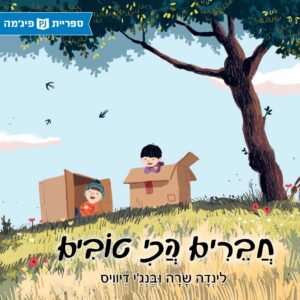 Best Friends
Best Friends 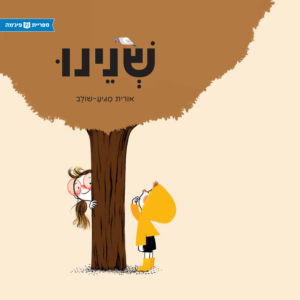 The Two of Us
The Two of Us 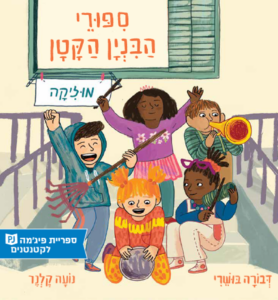 Music
Music 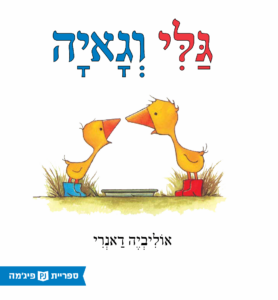 Gali & Gaya (Originally: Gossie & Gertie)
Gali & Gaya (Originally: Gossie & Gertie) 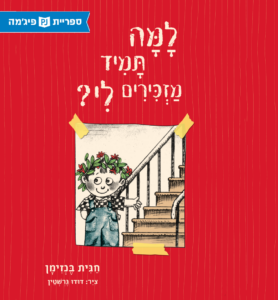 Why Do They Always Remind Me?
Why Do They Always Remind Me? 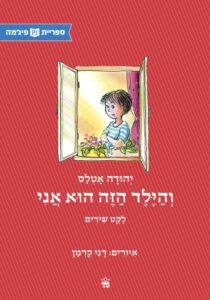 It’s Me
It’s Me 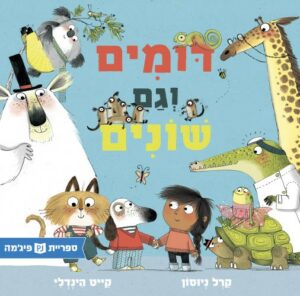 The Same but Different
The Same but Different 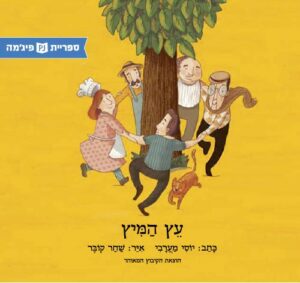 The Juice Tree
The Juice Tree 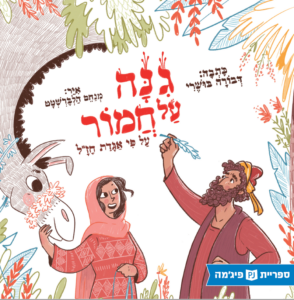 A Garden on a Donkey
A Garden on a Donkey 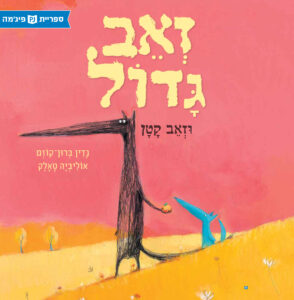 Big Wolf and Little Wolf
Big Wolf and Little Wolf 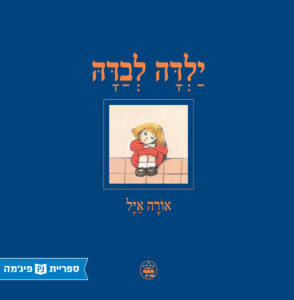 A Girl all by Herself
A Girl all by Herself 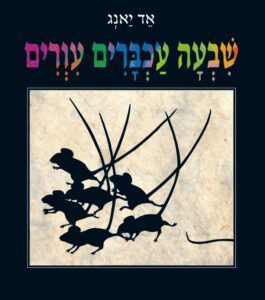 Seven Blind Mice
Seven Blind Mice 



